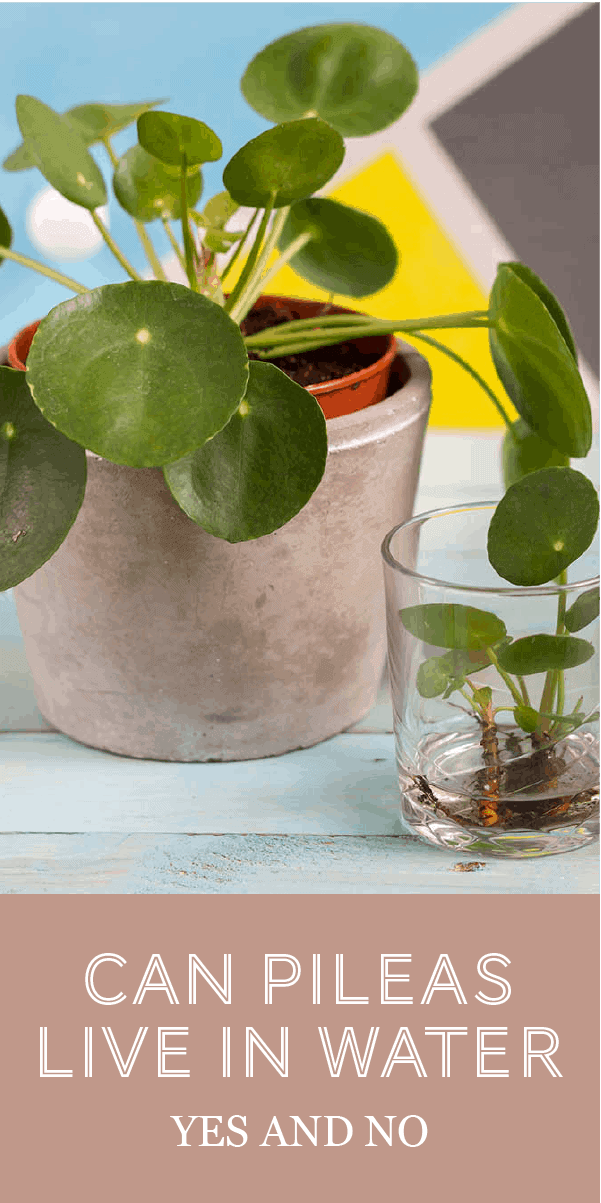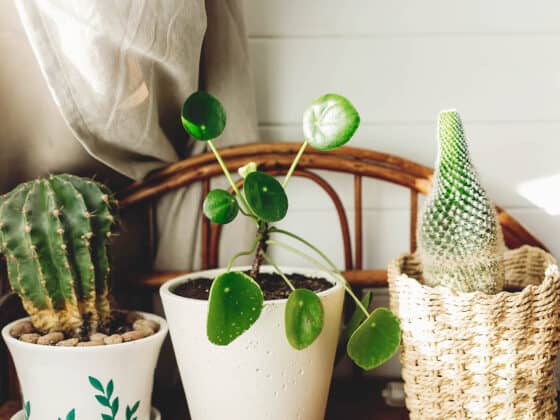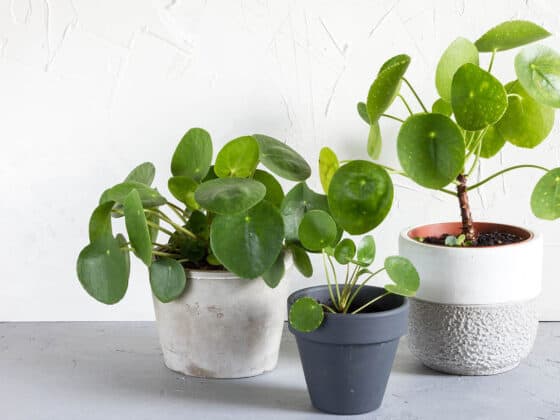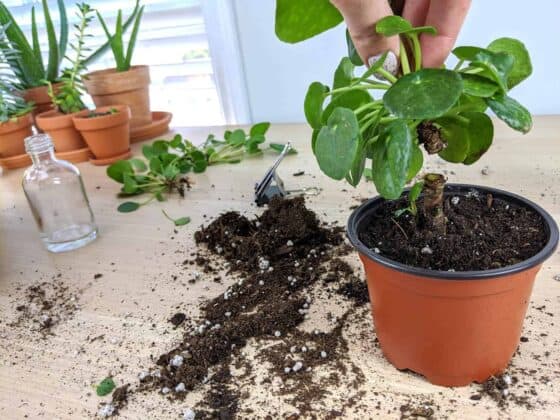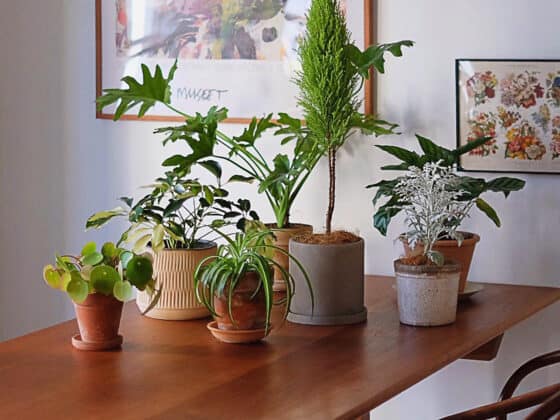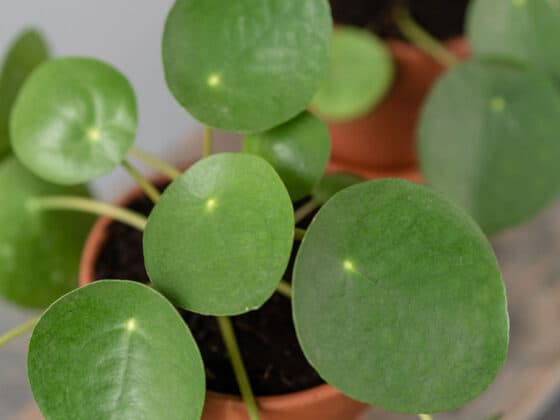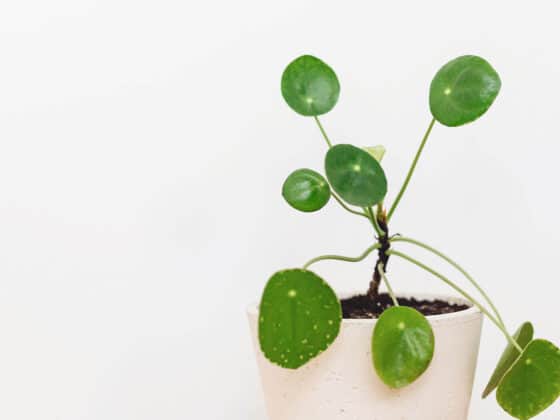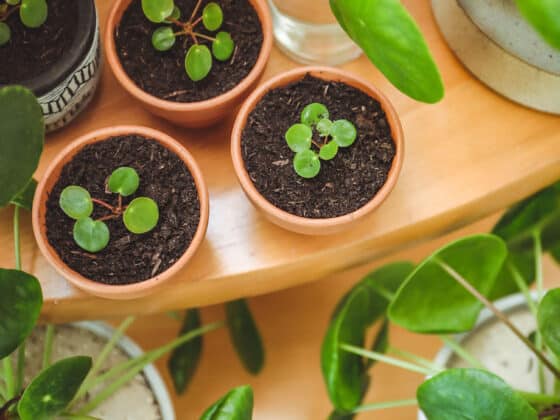There is a trend among houseplant lovers today to forget the soil and grow their houseplants completely in water. We know that Pileas can root in water, but can they grow and thrive in water alone?
Can Pileas live in water? Yes and no. The plant will root and even produce some new leaves when planted in water, but it will not thrive when planted this way. However, it is possible to sustain a Pilea in water with added nutrients in the form of fertilizer or rainwater.
There are a lot of houseplants that do well living in only water. In my opinion, Pileas are not one of them. If you want to have a plant in a vase without soil, I personally would choose another option like a philodendron or a pothos. But, if you have your heart set on a Pilea, it’s doable. It is just not the best method for growing a healthy Pilea.
The Short Answer – Yes A Pilea Can Live in Water, But It Won’t Thrive
Technically, a Pilea can get all that it needs to grow when planted only in water. However, a full, round Pilea is rarely achieved in this fashion.
If you want to experiment with Pileas in water, I would suggest using a few of the babies you remove from your mature Pilea, instead of the large healthy plant itself.
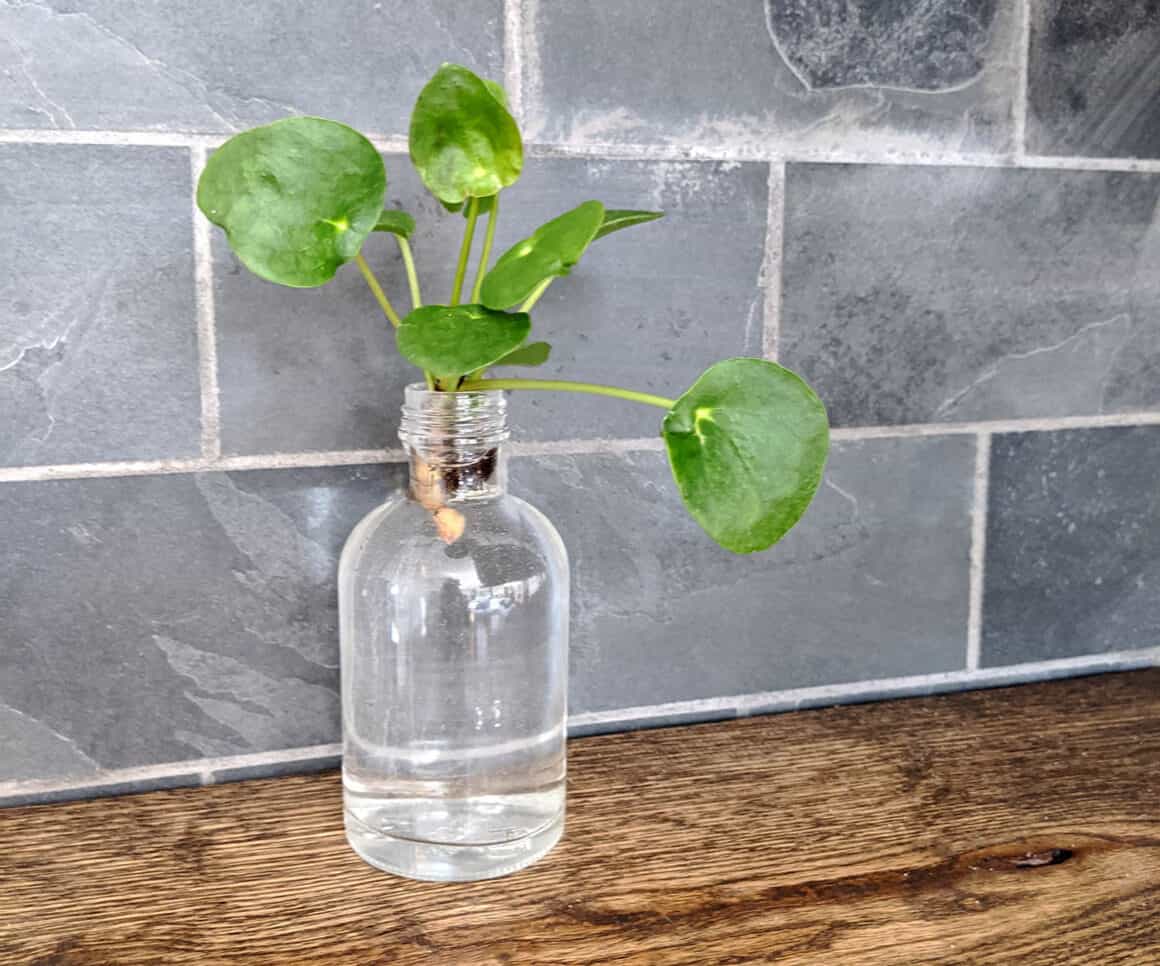
What Happens When Pileas Live in Water?
Water propagating is the most common method for reproducing Pileas. When a cutting is taken from a Pilea, usually in the form of a pup, the tip of the plantlet is placed in water, and in a matter of a few weeks, roots begin to form.
The roots that form while a Pilea is living in water vary from those that develop once it has been planted in soil. Water roots are usually thinner and are created to help the plant absorb oxygen from water, something that soil roots cannot do.
A Pilea that has been placed in water to root will develop their water roots. Then, once they are moved to soil, the plant will begin to grow the second type of roots as well.
When we keep plants living in water alone, they never get the option to develop their soil roots. Soil roots are larger and sturdier and are what help support a plant as they grow taller and bushier.
Pros & Cons of Planting Pileas in Water
When making any decision, I always like to weigh the pros and cons. I’ve created a list with what I believe are both the good and bad things about planting a Pilea in water.
Note – this is not a pros and cons list for propagating or rooting a Pilea in water. I always do that for a short period of time. These are the pros and cons for leaving a Pilea to live its whole life in water.
PROS:
Aesthetics: I’m assuming that the reason you are even looking this up right now is that you’ve seen houseplants planted in vases of water and you like the look of it. I do too! Planting in water is extremely trendy right now and the effect can be beautiful.
No Overwatering: Oddly enough, Pileas do not become over watered when planted solely in water. This may seem strange to you, but the problems that arise from a Pilea sitting in damp soil have much more to do with the fungus and pathogens that are activated in the soil than from the water itself. Without the soil, Pileas are not in danger of being overwatered.
CONS:
Not Enough Support: As Pileas grow they develop a central stalk that hardens, similar to a tree trunk. Over time, that stalk can become six to twelve inches tall or more. A Pilea without a solid foundation of roots in soil does not have the support it needs to grow tall in water.
All Nutrients Have To Be Added: Water alone does not contain all of the nutrients a Pilea needs to thrive. That means that you’ll have to be diligent on providing additional nutrition for your plant, something that potting soil normally aids with.
No Room for Babies: Pileas reproduce themselves in the form of small plantlets that pop up in the soil next to the mother Pilea. Without soil, you will be limited to whatever babies can emerge from the mother’s central stalk, which I believe will be minimal as a Pilea planted in water is rarely as healthy as its counterpart planted in soil.
Slower Growth & Shorter Life: While I don’t do this with my Pileas, I do have several vining houseplants that are planted solely in water. I rarely see new growth on them and when I do it is slow. The plants also tend to yellow and die eventually. A Pilea planted in soil can grow for a lifetime. A Pilea planted in water will not.
My Thoughts on Pileas In Water
Personally, I don’t plant Pileas in water because the cons outweigh the pros for me. I do like the look of plants grown purely in water, but I always opt for other species. However, getting a Pilea to live in water is doable. If you want to give it a try, there are some additional things you will need to know for the best chance of success.
You Will Have to Add Nutrients To The Water
If you want a Pilea to live for any long period of time in water, you’ll have to give it the nutrients it needs. Nutrients are different from food. A Pilea produces its own food through the photosynthesis process. Nutrients are absorbed from a plant’s surroundings. Pileas in water can produce their own food, but they’ll need your help with the nutrients.
In the wild, plants are able to get additional nutrients from rainwater, and by extending their roots to find untapped soil. When we move those plants indoors, they are constrained to what is available in their containers alone.
To thrive, plants need nitrogen, phosphorus, and potassium, as well as smaller amounts of other nutrients. Potting soil is fortified with these ingredients and your plant is able to absorb the nutrients it needs from the soil.
Pileas will not be able to absorb these same nutrients when planted in water alone. For this reason, you’ll have to add it into the water. Liquid houseplant fertilizer can be used for this and should be added in about once per month from spring to fall. I always dilute fertilizer to half strength for Pileas, no matter how they are planted. And since most fertilizers are formulated for plants potted in soil, I recommend choosing one made for hydroponics (like this one) for best results.
I recommend fertilizing with a synthetic fertilizer for Pileas in water. Synthetic fertilizers have ingredients that have already been processed and are immediately ready for uptake by your plant. Organic fertilizers need soil to break them down before they can be absorbed by your plant and are not ideal for water plants.
Side note: I do not fertilize Pileas than I am merely rooting in water. These cuttings will be fine to live in water until they can be moved to soil. This advice is for those people wanting to try to have a Pilea live its full life in water.
Change Pilea Water Often
Stagnant water can be a breeding ground for fungi, algae and pathogens. Because of that, you’ll need to make sure you are frequently changing the water in your vase or bowl. I would change it at least every two weeks, or if I noticed it starting to get dirty in between.
PH levels are also a concern when you do not change the water for your plant. When PH is not at the correct level, the roots of your plant can be damaged, and when the roots become damaged, the whole plant suffers.
To avoid growing algae in your vase or bowl, consider using a darker shade of glass such as amber or blue. Clear glass allows in more light which, in turn, breeds more algae.
What Water is Best for Pileas?
While tap water is not the best option for Pileas, it is generally acceptable. However, when it comes to planting Pileas only in water, I would not use what comes out of your tap.
Distilled water is a better option for this method, but it is also the option that will keep you running to the store. The process of distilling water removes chemicals and minerals from the water that may build up in your plant, and distilled water is the safest option to use for your Pileas.
However, leaving tap water out overnight actually mimics the distilling process. This is the method I use for watering most of my plants. I simply fill up a bottle of water and leave it on the counter for a day before treating my plants with it. When you leave tap water out in an open container for 24-48 hours, many of the chemicals evaporate out of the water, leaving it as a much better option for your houseplants than tap.
But in my opinion, the best option for a plant that is going to only be planted in water alone is collected rain water. Rain water has some nutrients in it and is a more natural option for your plants than distilled or tap. I have seen a few people who are able to successfully grow Pileas in rainwater alone.
The Best Method For Pileas is to Root Them in Water and Then Move to Soil
The best option for healthy Pileas is to root them in water and then move them into a container with quick draining potting soil. While I don’t leave my Pileas in water indefinitely, I do always start them in water for propagation.
If you have Pilea pups that you are wanting to root in water, the process is quite simple. Once a plant has been rooted in water and the water roots have reached an inch or two in length, I always plant it in soil.
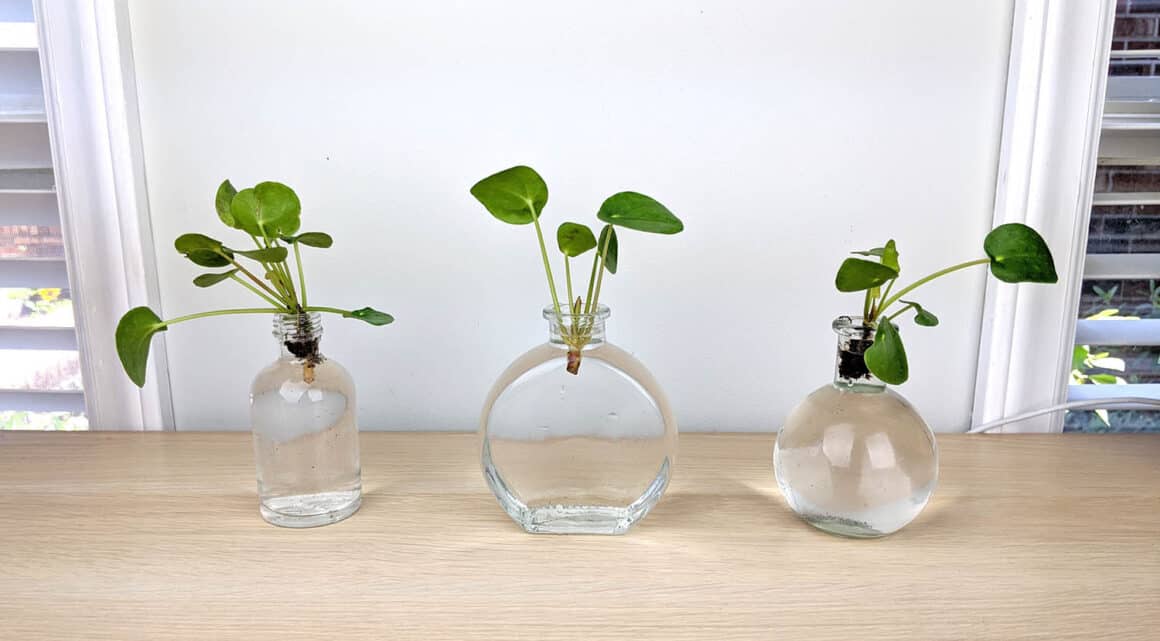
Rooting Pilea Pups in Water
To root a Pilea pup that has been removed from its mother in water, simply place the cutting into a small bottle of water. Be sure that only the base of the stem is in the water. Do not submerge any of the leaves. Then all you have to do is wait and watch your roots start to grow.
The type of bottle you use is up to you. I recently purchased some small, pretty bud vases that look like test tubes and beakers from my local Michaels craft store but have used old spice jars and small plastic water bottles in the past. The most important thing is to make sure that you can place your Pilea pup so that only the roots will reach into the water.
Once your new Pileas are in their water bottles, place them in an area of your home that gets bright, indirect light. Pileas cannot tolerate sunlight directly on their leaves, and a new plantlet is at a higher risk for being scorched by the elements. I like to put my baby Pileas on a table that sits about 3 feet from a bright, south facing window.
After a few weeks, you should start to see lots of roots growing from your Pilea cutting. Once those roots reach one to two inches in length, they are ready to be planted in soil.
Rooting Pilea Leaves in Water
Many people ask if they can root and propagate a Pilea leaf in water. A Pilea leaf will produce roots when placed into water. However, the stem does not contain the tissue needed to create a whole new plant.
If you want to root a Pilea leaf for a fun experiment, go ahead! The roots are fun to watch as they grow. But do know beforehand that this will not produce a new plant that can be placed into soil and turned into a mature Pilea. The leaf will live for a while, but will eventually die back and no new foliage will appear.
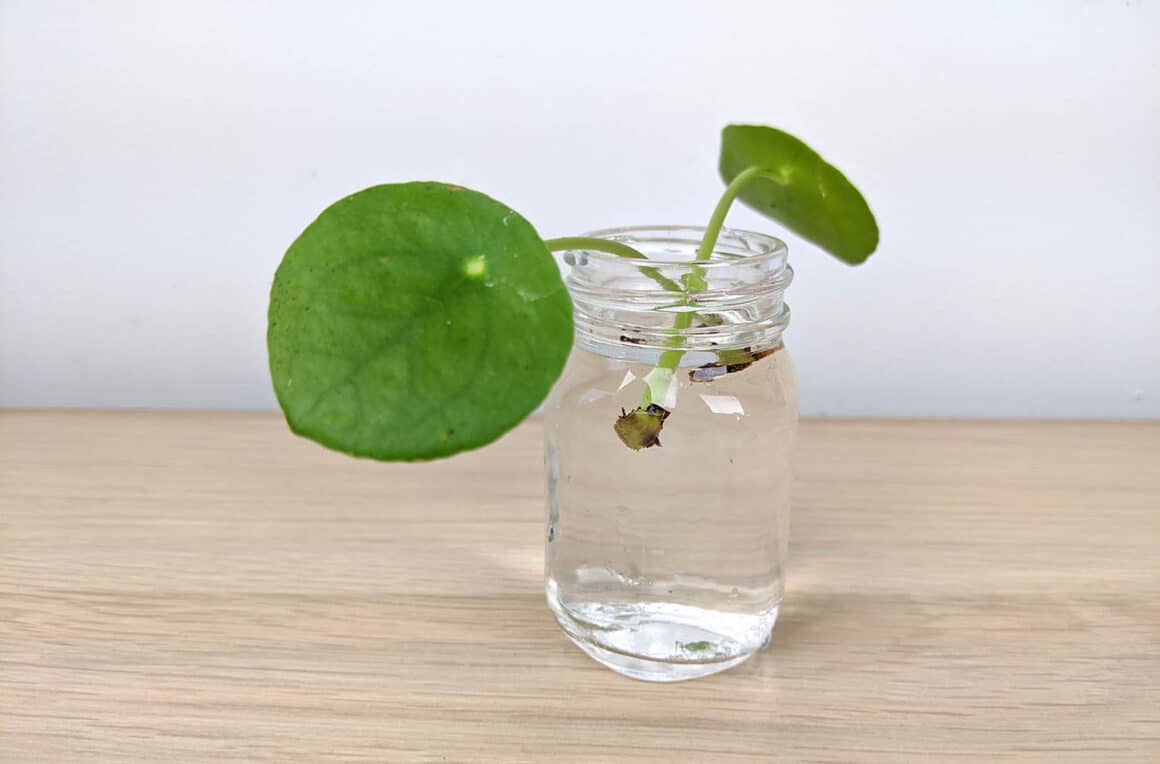
Final Thoughts
There are a lot of plants that do well to be grown without soil. In my opinion, Pileas are not one of them. Pileas can survive in water, but I have rarely seen them thrive.
If you are the type of person who likes to experiment, I say go for it, especially if you have a healthy mature Pilea that is producing lots of pups. But do not put all your eggs in this water basket. I would suggest propagating some of those pups in soil as well to have a better chance at a successful and healthy Pilea.
